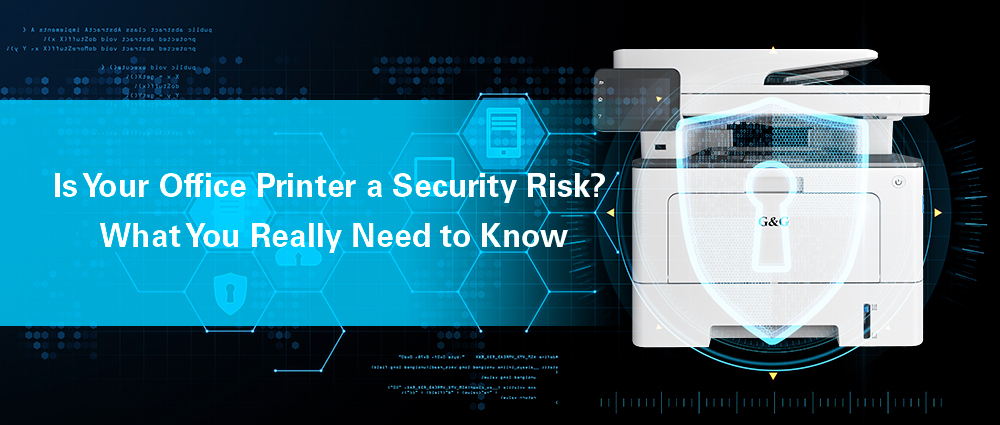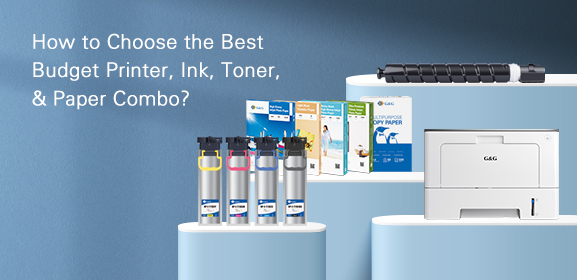-
Consumables
- Printers
- Industries
- Innovation
-
Partners
G&G Partner ProgramCo-Innovating Tomorrow Read More >
- About Us
-
Contact Us
 We hear about online threats every day. Someone loses their life savings to scammers. Fraudsters have hacked into large corporate databases and have sold information on the dark web.
We hear about online threats every day. Someone loses their life savings to scammers. Fraudsters have hacked into large corporate databases and have sold information on the dark web.
There are also market tensions. Trade wars and changes in government policy have sparked uncertainty, causing a volatile global economy. Market pressures are intensifying, competition is fierce, and the spread of misinformation has become a favored strategy. Nowhere is this more evident than in the world of office printing, where narratives about security risks are being twisted to serve commercial and geopolitical agendas.
You’ve probably seen the headlines:
"Your printer could leak your company's secrets!"
"Third-party cartridges could be spying on you!"
So, what are you to believe? How much of this is fact? Is it possible that fiction is being written and shared, designed to protect profits in those markets that are declining?
Let’s expose the myths and reveal the real story.
Printer chips aren’t spying on you—fearmongering is.
Like any device on your network, printers must be properly configured and maintained. Best practices include:
Updating firmware, when necessary (and reviewing update notes critically),
Changing default passwords,
Monitoring network traffic for anomalies,
Employing fleet management tools to control access and data flow.
Printers have chips in them, and you must take precautions to protect the information and data you send from your computer to your printer.
 However, warnings that blame the toner or ink cartridge inside your printer for cybersecurity risks are a pure distraction. There is a lot of finger-pointing at third-party cartridges, too, that contain after-market chips. Be aware that this is commercial self-interest dressed up as technical expertise.
However, warnings that blame the toner or ink cartridge inside your printer for cybersecurity risks are a pure distraction. There is a lot of finger-pointing at third-party cartridges, too, that contain after-market chips. Be aware that this is commercial self-interest dressed up as technical expertise.
Printer OEMs frequently push firmware updates with claims of “enhanced security.” While regular updates are important for genuine cybersecurity, many OEM updates have an ulterior motive: using the chip in the printer to block the use of third-party cartridges.
Time and again, these updates have:
Rendered perfectly good third-party cartridges unusable,
Forced customers to purchase more expensive OEM replacements,
Offered no real, tangible improvement to printer cybersecurity.
This tactic has drawn scrutiny from regulators worldwide. In some cases, OEMs have faced lawsuits alleging anti-competitive behaviour for misleading consumers under the guise of "security."
The truth is that many firmware updates are not about safeguarding your business. They are about safeguarding OEM profits.
OEMs aren’t protecting your network. They’re protecting their profits.
1. Printer Chips Are Major Cybersecurity Threats
Today, printers are highly sophisticated machines, often equipped with their own processors, memory, and embedded software. Naturally, any connected device carries some cybersecurity risk. However, the idea that printer chips themselves are major conduits for data theft is wildly overstated.
The chips inside printers manage basic functions like:
Processing print jobs,
Managing internal resources (like toner levels or paper trays),
Securing user authentication for print release.
Do printer chips "spy" on your data?
No. Data processed by printers generally stays local and is flushed after printing. While printers might store temporary information for queued jobs, they are not independently transmitting sensitive data unless configured to do so (such as in a managed print services environment).
For a printer to become a true cybersecurity threat, it would have to be:
Deliberately infected with malware through a targeted attack,
Configured improperly (such as open ports or default passwords left unchanged), or
compromised through an extremely rare supply-chain attack.
Such scenarios are possible, but they are exceptionally rare compared to the everyday risks posed by unpatched laptops, unsecured Wi-Fi, or phishing emails.
2. Cartridge Chips Could Leak Sensitive Information
Printer cartridges—both OEM and third-party—often come equipped with chips. These chips perform simple, non-invasive functions such as:
a. Confirming cartridge authenticity,
b. Monitoring ink or toner levels,
c. Reporting page counts.
That’s it. They are not "smart" devices capable of capturing, storing, or transmitting user documents or confidential information.
As German-based Volker Kappius clearly outlined in his recent RTM World article, “these chips simply don’t have the computational power or access privileges to engage in cyber espionage. They are, in essence, glorified counters and status reporters.
Claiming that cartridge chips pose cybersecurity threats is not a factual statement—it’s a strategic marketing tactic by OEMs determined to discredit third-party competitors.
If your network is vulnerable, your printer isn’t the biggest problem.
3. Third-Party Chips Are Less Secure Than OEM Chips
Another piece of fiction circulating in the market is that third-party chips are inherently riskier than OEM chips.
In reality:
a. Third-party chips are typically designed to replicate OEM functionality as closely as possible.
b. Leading third-party manufacturers follow stringent international quality and safety standards.
c. The chips used by reputable third-party brands are often simpler, less network-connected, and therefore less exposed to cybersecurity vulnerabilities than their OEM counterparts.

Moreover, because third-party suppliers have faced years of litigation and scrutiny, they often go to extraordinary lengths to ensure compliance and security.
So why the anti-third-party rhetoric?
It’s simple: OEMs are fighting for survival in a declining print market. Locking customers into expensive, branded consumables is critical to protecting their annuity revenue streams.
4. Deeper Layers: Geopolitics and Fearmongering
Let’s not ignore the global context. Geopolitical tensions, especially between the West and China, have given rise to broad suspicion toward Chinese manufacturers, including those making third-party printer supplies.
OEMs often exploit these fears by insinuating, without evidence, that using non-OEM cartridges could somehow expose businesses to foreign espionage. The facts simply don’t back this up.
Third-party suppliers operating globally are subject to strict standards, and cybersecurity best practices apply regardless of country of origin.
It’s important to ask yourself: “Who benefits from stoking these fears?” The answer is simply OEMs protecting their shrinking monopolies.
Meanwhile, real cybersecurity threats—such as ransomware, insider attacks, or outdated corporate networks—are far greater risks than your printer cartridges.
So, don't fall for the fear.
In a market environment rife with misinformation, it’s important to think critically. This will reduce unnecessary fear and allow you to return to a happy printing experience.
Printer chips are not clandestine spies.
Cartridge chips cannot steal your data.
Third-party chips are not less secure than OEM chips.
Firmware updates are often about profit protection, not security protection.
Focus your cybersecurity efforts where they matter most—and don’t let fear-mongering tactics cloud your judgment. When you peel back the layers, the truth is clear: The real security risk isn't in your cartridge—it's in believing the myths designed to manipulate you.






